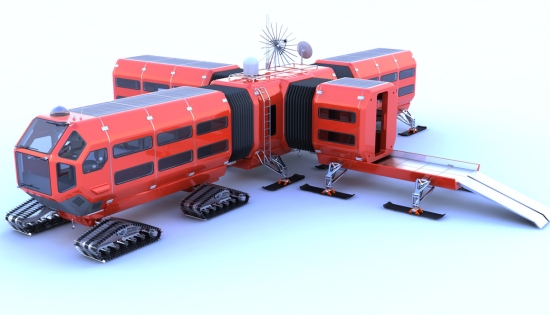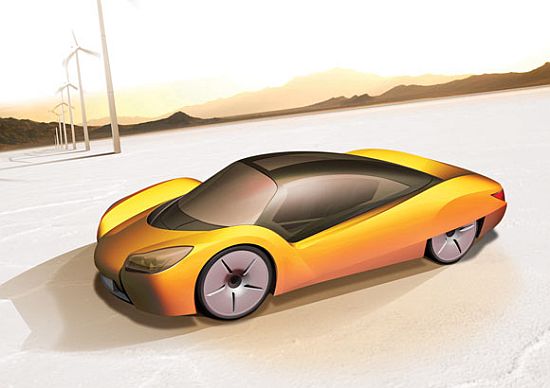When you compare them to fossil fuel vehicles, electric vehicles are usually expensive. Furthermore, they also have lesser power, speed, and operating range. Nevertheless, most of them are zero emission, which covers most of these drawbacks. In addition, in comparison to the popular vehicles out there, these are still in a somewhat experimental phase. Moreover, in the near future, when they would become mainstream, we are bound to see wonderful developments in them. In fact, even right now, there are many inexpensive electric vehicles in the market. Furthermore, Vehicle concepts like The Multi-use Polar Vehicle show us how electric vehicles might soon overcome their shortcomings. In addition, these vehicle designs might prove our haven in a world where both air pollution and oil prices are rising.
Multiple-use Polar Vehicle

Eco Factor: Polar vehicle powered by hydrogen fuel cells.
The brainchild of Matthieu Tarrit, Charles Zamolo, and Hugo Cerf, the Polar Vehicle is a prospective project in association with an NGO by the name of International Polar Foundation. Owing to its innovative design, the vehicle adapts itself to the surroundings and the needs of the scientists researching in hard-to-live places such as Antarctica.

Furthermore, the front of the Polar Vehicle is the truck tractor, while its center is the where all the controls rest. The vehicle aims to solve two main purposes. First, to make the scientists travel with easy on the harsh terrain. Second, to serve as a base camp with all amenities.

In the base camp mode, the vehicle arranges itself in the form of a star. This allows it to save all the heat and solar energy that falls on the roof of the vehicle. The energy for movement and to power the onboard systems comes from a fuel cell. This cell combines oxygen and hydrogen to produce electricity for the four electric motors.

You can easily dismantle and reconfigure the vehicle in a unique arrangement. This makes it possible to use the vehicle in different places. Furthermore, you can also very easily dismantle and store the vehicle in shipping containers for easy transport.

Thanks: [Matthieu Tarrit]
Some more eco-tech concepts like Multiple-use Polar Vehicle
1. VETP URBANO

Eco Factor: Zero-emission taxi powered by electricity.
Car designer Rober Digiorge is one of those who wants to see electric vehicles not only in your garages but as taxis as well. Rober has shared with us his latest car design, which he calls the VETP URBANO.
The VETP URBANO is an ideal vehicle to transport passengers over short distances in largely populated areas. The vehicle maintains the traditional look of a taxi and remains pleasant both to the environment and passengers sitting inside. Powered by a 3000W brushless motor, the car will reach a top speed of 80km/h and offer a driving range of over 150km on a full charge. In addition, you can recharge the onboard batteries in 6 hours using a conventional wall outlet.
2. Rinspeed’s UC

Eco Factor: Zero-emission compact car powered by batteries.
Swiss automobile and concept powerhouse Rinspeed says that the company will be showcasing a compact city car, The UC?, at the Geneva Motor Show. The compact vehicle is just 2.5m in length. It is intended to help avoid gridlock in inner cities.
The company claims that the vehicle isn’t just a car, but an innovative transportation system as with an advanced railcar loading system it will add the option to cover long distances by train. The lightweight car operates with a central joystick and delivers 124 Newton meters of torque. This propels the vehicle to a top speed of 110kph, and the onboard batteries have an operating range of 120km.
3. Trik.E

Eco Factor: Trike powered by electricity.
Folks over at Speed Studio Design have designed a three-wheeled vehicle that they claim to be a true alternative to cars for around-town transportation. Running on one rear wheel, the vehicle provides a comfortable way to navigate in even the busiest city lanes.
The Trik-E comes with weather protection to allow you to drive it around the year. Designed especially for city driving, the vehicle would have a decent capacity for a few bags of groceries. An innovative lean-steering system provides nimble yet secure handling. Being compact the vehicle is easy to park and has a decent top speed of 32kph. The designers don’t state the operating range the vehicle is expected to have, but with the pedal-power system available as a backup, you’ll never be left stranded without a charge.
4. E.V.C low-emission hybrid vehicle

Eco Factor: Concept low-emission vehicle powered by a hybrid engine.
The Expedition Vehicle Concept or E.V.C by designer Prodan Dragos is a versatile and adaptable vehicle that can be configured to suit the requirements of the user. The concept vehicle can be changed from an enclosed camping vehicle to an open-top cruiser in minutes.
The E.V.C is designed to be powered by a hybrid engine. The concept features a range of different sized hexagonal windows that also act as photovoltaic cells to help provide additional electrical charge.
The interior of the EVC has four full-size seats. The front seats can swivel around to face backward and make use of extra space when parked. The rear end of the vehicle can be extended for more space and also allowing the rear seats to fold out flat and provide a sleeping area.
5. iChange

Eco Factor: Zero-emission car to run on electric motors.
Rinspeed has got a reputation for developing weird and unusual cars for the Geneva Auto Show. While we were still thrilled about the sQuaba, which was launched last year at the same show, news has surfaced that the company’s plans for next year rest in a car they call the “iChange.”
The iChange will be a “1-2-3-seater” powered by a zero-emission electric motor. It would generating 130kw of power, and that’s where a normal car ends and Rinspeed takes over. Furthermore, the car will essentially be a sports car with a single seat for the driver. However, if you want to use it as a multi-purpose vehicle, you can just flip a button and it turns into a compact sports van with two more seats toward the rear. The car will feature an extremely low weight and aerodynamic drag, thus reducing the power consumption.
6. AirRay

Eco Factor: Zero-emission electric vehicle designed to run on renewable energy.
Renewable energy company EarthSure has announced that the company is planning to build an electric vehicle. It would harness solar and wind energy to fuel its battery bank. Dubbed AirRay, the patent-pending design will be having a solar roof and four wind turbines. These would provide all necessary electricity to charge the batteries.
AirRay’s entire system is unique. In addition, as the roof of the car carries a solar honeycomb membrane panel which collects the sun’s rays when parked or moving and transfers the collected energy to the main storage system of the vehicle.
The car also has three wind turbines on the front hood and an additional wind turbine in the trunk of the car. It grasps at the airflow that surrounds the car when driving. In addition, the company incorporates the vehicle with Vehicle-to-Grid capabilities. However, it will enable the users to transfer renewable energy back into their homes for use in their household, and can also transfer electricity back to the grid to lower their bills. It could be of great help in making the house completely off-grid.



